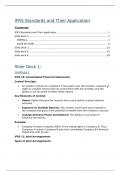Summary
IFRS and Group Accounting Summary
- Course
- Institution
This is a summary covering all the slides taught in IFRS and Group Accounting by Gysemberg Sebastiaan and Kegels Bert. It helps in having a overview of all the IFRS and IAS covered in class which will be useful for exam preparation.
[Show more]



